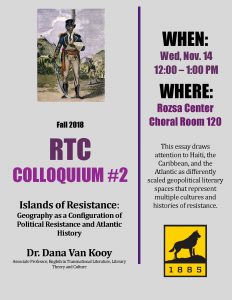 Please join the Department of Humanities for a Rhetoric, Theory and Culture Colloquium on Wednesday, November 14 titled “Islands of Resistance.” Dana Van Kooy, associate professor of english in transnational literature and literacy theory and culture, will present “Islands of Resistance: Geography as a Configuration of Political Resistance and Atlantic History” (see abstract below). This essay draws attention to Haiti, the Caribbean, and the Atlantic as differently scaled geopolitical literary spaces that represent multiple cultures and histories of resistance.
Please join the Department of Humanities for a Rhetoric, Theory and Culture Colloquium on Wednesday, November 14 titled “Islands of Resistance.” Dana Van Kooy, associate professor of english in transnational literature and literacy theory and culture, will present “Islands of Resistance: Geography as a Configuration of Political Resistance and Atlantic History” (see abstract below). This essay draws attention to Haiti, the Caribbean, and the Atlantic as differently scaled geopolitical literary spaces that represent multiple cultures and histories of resistance.
Please join us 12 p.m. (noon) Wednesday, November 14 in Rozsa Center room 120 (choral room).
Abstract:
Islands of resistance. The phrase commonly refers to isolated pockets of organized and oppositional force. Significantly, when interpreting the phrase, the emphasis falls more on the geographical features of an island than on the refusal to comply. The geographical imagery encircles and confines resistance: limiting its effectiveness to a series of singular actions or to a small, containable collective movement. In the cultural imaginary, the island represents a point of stasis in the midst of an immensely larger—very fluid and indomitable—natural force. However, the island’s characteristics—its isolation, its remoteness from everywhere else, and its unique ecology—also produce a synecdoche: the world is an island. What I find relevant here is how geographical markers reconfigure the politics of the phrase, both positively and negatively.
In the Romantic period, islands of resistance constitute a global expanse of spatial and temporal assemblages that encompass isolated rural agricultural estates, mining districts, mountain ranges, and wild “wastelands.” Metropolitan areas and cities can also be represented as islands, as well as nations and other geo-politically defined areas. For the purposes of this essay, I will focus more specifically on the island of Haiti. This island represents a geo-historical watershed: intertwining slave revolts, reactionary invasions, and revolutionary acts of independence, which culminated in the collective establishment of the first independent black state in the New World.
Focusing specifically on Leonora Sansay’s narrative depictions of Haiti’s history and its Revolution in her novel, Secret History (1808), I want to locate and map the shifting depictions of Haiti’s geography and how these markers shape, challenge, erase, and make manifest the many political possibilities for this island of resistance.